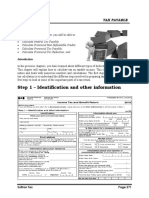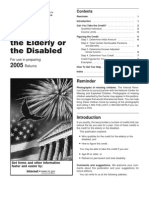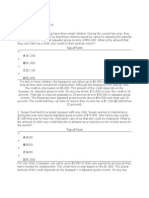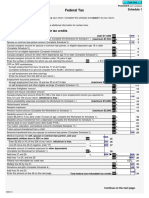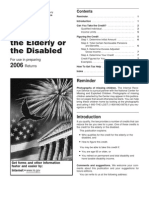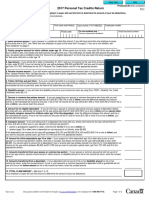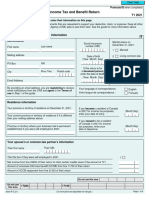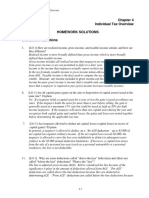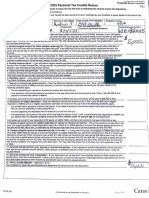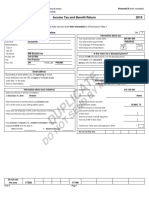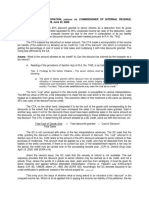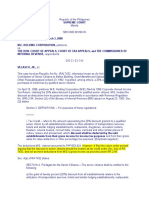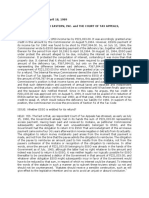Level 1 Course –
Chapter
Tax year 2021
1
�Topic of the Day
Federal Non-refundable Tax Credits
2
� Federal Non-refundable Tax Credits
As the name states, non-refundable tax credits reduce tax payable to zero.
Any amount that remains from the credit is automatically forfeited by the
taxpayer.
Each government allows taxpayers to claim a percentage of their non-
refundable total tax credits and reduce their taxes payable by that amount.
The federal government allows taxpayers to claim 15 percent of their non-
refundable tax credits.
3
�Basic Personal Amount - Line 30000
All taxpayers can claim a basic non-refundable tax credit for their income tax,
known as the personal amount. It is adjusted annually to allow for inflation
and other factors, in 2021 the personal amount for federal taxes was $13,808.
Each province and territory also sets a personal amount for provincial or
territorial taxes.
Example:
Mark taxable income is $15,000 for the year. How much federal income
taxes will he pay?
Mark only pay federal income tax over the base amount $13,808, so
$15,000 – $13,808 = 1,192 at rate 15%.
4
�Age Amount- Line 30100
A taxpayer qualifies for age credit of $ 7,713 if he/she is 65 or older by
December 31st. The age credit is for lower income seniors.
Age credit amount starts to reduce by 15% as income exceeds $38,893 &
disappears entirely at an income level of $90,313. A taxpayer entitled to
full age credit if their income is $38,893 or less.
Unused age credit can be transferred to spouse. This will be discussed
under Line 32600 later in this chapter.
5
�Age Amount
Example:
Paul turned 65 during the year & his income is $ 41,000 from T4 slip. How much
age amount can he claim?
Paul’s age credit is $7,396.95 on schedule 1.
6
�Age Amount
Example:
What if Paul's income is $ 96,000 from T4 slip?
How much age amount can he claim?
Paul’s age credit is $0.00 on schedule 1.
7
�Spousal Amount - (Line 30300)
"Married" means you have a spouse. This applies only to a person to
whom you are legally married.
“Living common-law" means you are living with a person who is not your
spouse, but with whom you have a conjugal relationship, and to whom
at least one of the following situations applies:
If you have lived together for 12 continuous months.
They are the parent of your child by birth or adoption.
8
�Spousal Amount - (Line 30300)
Spousal amount can be claimed by the taxpayer who is married or common law. The
taxpayer does not have to be married or in common law relationship throughout the
year to claim this credit. To claim this credit, your spouse or partner’s net income
must be less than the threshold amount. Threshold amount is set by CRA on annual
basis and is indexed to inflation.
9
�Non-Resident Spouse
Nonresident spouse is one who is not resident of Canada. The taxpayer
can still claim spousal amount for nonresident spouse if:
The taxpayer supports him or her financially.
The amount of support payment must be sufficient for a person to
live on.
CRA determines that the amount of support payment is sufficient
based upon standard of living in that country.
10
�Example
Donald is marred to Anita. His social insurance number is 787-887-876. Use
your address. He received T4 slip from Bell Canada, Box 14 is $40,000. Anita’s
income is $ 5,000.
11
�Separation & Spousal Credit
"Separated" means that you have been living apart from your spouse or
common-law partner because of a breakdown in the relationship for a period of
at least 90 days and you have not reconciled. Once you have been separated for
90 days because of a breakdown in the relationship, the effective day of your
separated status is the day you started living apart.
12
�Example
What if Donald got separated from Anita on August 1st. Anita’s net income up
to August 1st is $1,900.
13
�Eligible Dependent Amount (Line 30400)
Eligible dependant credit is non-refundable tax credit which can be
claimed by single parents. You can claim this credit for dependent
children or parents or grandparents who are living with you and
are financially dependent on you.
Additionally, only one person per household is allowed to make this
claim, regardless of the number of dependents in the house.
14
�Eligible Dependent Amount (cont’d)
Who can claim:
Taxpayer who is Single, Divorced, Separated, or Widowed.
Taxpayer doesn't have to be single, divorced, separated or widowed
throughout the year, but only at some time in the year
15
�Eligible dependent (cont’d)
Single parents can claim eligible dependents credit for a dependent who is:
child under the age of 18 and living with you
parent or grandparents
dependant over the age of 18 with mental or physical impairment and
living with you.
16
�Example
Andrea is single mother. Her SIN is 870-001-500. She received a T4 slip
from Bell Canada, Box 14 = $ 50,000. Use your own address. Her daughter,
Sonia was born on April 4th, 2019. Can Andrea claim amount for an
eligible dependent?
Answer: Andrea can claim Sonia as eligible dependent.
17
�Web Example
Andrea supported her 55 years old widow mother who lives with her.
Her mother has no income.
Answer: Andrea can claim amount for eligible dependent.
18
� Example
Ken & Lee are married with two children. They were living separated for
three months due to breakdown in their relationship. Can they each
claim eligible dependent credit?
Answer:
They can each claim one of the children as amount for an eligible dependent,
If they meet the following conditions:
They maintained separate households during the period of separation.
During three months of separation, they each took care of a child in the
separate household.
19
�Example
Seanna is a single mother. Her 22 years old daughter, Vannia who is university
student lives with her. Can Seanna claim amount for an eligible dependent?
Answer:
No. You can make a claim for adult dependents unless they have mental or
physical impairment (Exception is parents or grandparents)
20
�Example
Mary and Suson are sisters, and both are single mothers. Mary has five
years old son and Suson has seven years old daughter. Mary and
Suson both live together to share their expenses. Can they both claim
equivalent to spouse amounts for their children?
Answer:
No, only one claim per household is allowed.
21
�Adoption Expenses (Line 31300)
Taxpayer can claim adoption expenses for a child who is under 18 years of age at
the time that the adoption recognized by a government in Canada.
Adoption expenses may be split between two parents, but the combined total
expenses cannot exceed the $16,729 maximum limit for each child.
Parents can claim the expenses in the tax year that includes the end of the adoption
period in respect of the child. Adoption period starts when the adoption application
is submitted, and the period ends when the application is finalized, or child begins
to live permanently with parents.
22
�Eligible adoption expenses
Fees paid to an adoption agency licensed by a provincial or territorial
government.
Reasonable and necessary travel and living expenses of the child and the
adoptive parents.
Court cost and legal and administrative expenses related to an adoption
order in respect of that child.
Document translation fees.
Mandatory fees paid to a foreign institution.
23
�Canada Employment Amount (Line 31260)
Taxpayers who have employment income can claim a non-refundable credit.
The maximum amount on which it is calculated is the lesser of the taxpayer’s
employment income and $1,257.
Note that all income included on Lines 10100 and 10400 qualify for the Canada
employment amount.
24
�Example
Jack works in a Tim Horton & his employer issued him a T4 of
$15,500. Would he qualify for employment income credit?
Answer:Yes, Jack can claim amount of $ 1,257 on line 31260.
Example:
What if his T4 income shows total amount of $500.
Would he still qualify for employment income credit?
Answer:
His employment income credit is the lesser of:
Employment income: $500 or
Employment income credit: $1,257
Canada employment credit will be $ 500.
25
�Disability Amount – (Line 31600)
A person who has a physical or mental impairment that substantially limits
one or more major life activity, is called disability. The disability tax credit
(DTC) is a non-refundable tax credit that helps persons with severe mental
and physical disabilities to reduce tax liability. To claim this credit, disability
Form T2201 must be approved by CRA. The taxpayer can transfer unused
portion of this credit to spouse or another supporting person. Unused
credit means first reducing your tax payable to zero.
Maximum disability amount is $8,662.
26
�Example
Jack works for Home Depot and has T4: Box 14 is $ 45,500, Box 16 is
$ 2,205, Box 18 is $ 718.90. Jack’s disability tax credit is approved by
CRA. What credits can he claim on schedule 1?
Answer:
Basic Personal amount: $13,808.00
CPP Credit: $2,002.71
EI Credit: $718.90
Canada employment amount: $1,257.00
Disability Tax Credit: $8,662.00
Total non-refundable credit is: $26,448.61
27
�Example:
How federal income tax he would have to pay?
Based on his taxable income of $45,297.71
Federal tax payable (Line 40400) $6,794.66
($45,297.71 x 15%)
Nonrefundable tax credits (Line 35000) $3,967.29
($26,448.61 x 15%)
Net federal tax payable (line 42900) $2,827.37
28
�Disability Amount Supplement
Taxpayers under the age of 18, will receive additional disability
supplement.
Maximum supplement is $ 5,053.
Unused disability amount along with supplement can be transferred to
the supporting taxpayer.
29
�Disability amount transferred - (Line 31800)
Unused disability credit can be transferred from:
Spouse;
Child, grandchild;
Parent or grandparent
Brother, sister, aunt, uncle, niece or nephew.
30
�Example
Mary Johnson is widowed & has 25 years old daughter, Sona who is
dependent to a wheelchair. Mary’s SIN is 100-000-041. Mary received T4
slip from Bell Canada, Box 14 = $ 36,800. Sona does not have any
income. Can Mary claim eligible dependent or any other credit?
Answer: Mary can claim following credits:
Eligible dependent amount (line 30400): $13,808
Disability Tax Credit (line 31800): $8,662
31
�Do it on Web: Dependent
32
�Example
Refer to last example from slide 31. What if Sona ‘s net income is
$6,200. Can Mary claim an amount for an eligible dependent?
Answer: Mary can claim following credits:
Eligible dependent amount (line 30400): $7,608
Disability tax credit (line 31800): $8, 662
33
�Example
Refer to last example from slide 31. What if Sona ‘s net income is
$10,500. Can Mary claim an amount for an eligible dependent?
Answer: Mary can claim following credits:
Eligible dependent amount (line 30400): $3,308
Disability tax credit (line 31800): $8,662
34
�Do it on web: Net income
35
�Interest paid on student loan (Line 31900)
Taxpayers who make student loan payments on a qualified student loan
may be able to claim interest expense on their tax return.
Both the federal and most provincial governments offer student grants
and loans to students in financial need.
Canadian student loans are available to citizens, permanent
residents and protected persons who meet course requirements.
Student loan must be under the Canada Student Loans Program or a
provincial student loan program, to claim interest portion of the
payments.
36
�Interest paid on student loan (cont’d)
Interest on student loan can be claim in current year tax return or carry
forward to apply to any next five years' returns.
The amount of interest paid on student loans is deductible on Line 31900
of Schedule 1.
This credit cannot be transferred.
37
�Example
Jonna is 24 years old and has net income of $41,000. Jonna paid
interest of $950 towards her federal student loan. Can she claim
interest on student loan? Can she transfer the amount to her
parents?
Answer: She can claim interest on student. Student loan interest
cannot be transferred.
38
�Example
Sam is studying full time at local university. Sam went to TD Bank and took
personal loan of $20,000 to pay his tuition fee. His TD bank statement shows
interest on loan is $3,500. Can he claim interest on his tax return?
Answer: The loan must be approved under Canada Student loan or Provincial
student loan program.
39
�Tuition Fees T2202 & TL11A (Line 32300)
Eligible tuition fees mean fees paid to Canadian institute for the courses
taken at a post-secondary education institution to obtain or improve
their skills as occupation. Fees paid to post-secondary educational
institution outside Canada must be at post-secondary school level to be
eligible for the tuition tax credit.
40
�Examination Fees (cont’d)
Examination fees paid to an educational institution, professional
association, provincial ministry or other similar institution, to take
an occupational, trade or professional examination that is required to
obtain a professional status recognized by federal or provincial statute,
or to be licensed or certified as a tradesperson, to allow you to practice
the profession or trade in Canada, may be eligible for the tuition tax
credit.
41
�Tuition Fees paid to Canadian Institutions (T2202)
To qualify, the fees you paid to attend each educational institution must be
more than $100.
All courses will qualify whether they are full time, part time, night course
or correspondence courses.
42
�Tuition Fees paid to Institutions outside of Canada (TL11A)
A university outside of Canada: Course must be if the student was enrolled
full-time in a course that was at least 13 consecutive weeks long and that
would lead towards a degree.
Full-time attendance is required for university outside of Canada and
course must be leading to a degree (not just a diploma).
The university must be recognized by a nationally accepted accrediting
body of its country.
43
�44
�Tuition Fees – Cont'd
The student must be over 16 years of age or over or the fees must
be paid to a post-secondary school.
The tuition fee paid to each Canadian educational institution in a year
must be over $100 to qualify. Tuition fees is claimed in the year the
course is completed. For example, if a student paid tuition fees in 2020
but for a course commencing in 2021.
45
�Unused tuition fees
Unused tuition fees can be carried forward or transferred to a spouse,
parent or grandparent. Carried forward tuition fees from previous years
can't be transferred to anyone.
46
�Transferring unused tuition fees
Parents cannot directly claim child’s tuition fees on their tax return. If the parent
wishes to claim child’s tuition fees, it is advisable that the student should file their tax
return and report transfer of unused tuition amount. The maximum tuition fee
transferrable is $ 5,000. Schedule 11 is used to report tuition fees, calculation of
tuition transfer or carrying forward tuition fees.
47
�48
�49
�Example
Don has T4 income of $ 28,700. His SIN is 100-000-009. Use your own address.
He was full time student at Georgian College for 4 months. He has a T2202 that
show tuition fees of $7,500.
50
�Example
Let's look at Page number 248, example number 43
51
�Amounts transferred from spouse (Line 32600)
The taxpayer can transfer certain eligible tax credits to his/her spouse
after reducing his/her tax payable to zero.
Age amount (unused portion)
Pension amount (unused portion)
Disability amount (unused portion)
Tuition amount.
The taxpayer must complete schedule 2 to transfer any unused credits.
52
�Example
Jason and Dona are married. Jason was born on October 15th, 1956. Dona’s
date of birth is October 10, 1957. Dona’s has no income, while, Jason’s net
income for the year is $ 40,000. Dona went part time to evening classes for
two months and paid sum of $950 in tuition fees. Can Jason claim any credit
for Donna?
Answer: Jason can claim:
Spousal credit (line 30300) $ 13,808.00
Tuition amount transferred from spouse (line 32600) $950.00
53
�Medical expenses (Line 33200)
A taxpayer can claim a non-refundable tax credit for medical expenses
paid by the taxpayer or the taxpayer's spouse or partner. Claimable
medical expenses include taxpayer’s, spouse’s and for children under the
age of 18.
Omission is the biggest mistake that taxpayers make in claiming medical
expenses.
54
�Medical expenses (cont’d)
Medical expenses can be claimed if they were paid within any 12-month period
ending in the current tax year and was not claimed in the prior tax year.
Generally, all eligible medical expenses can be claimed, even if they were
incurred outside of Canada. When medical expenses are reimbursed by an
insurance plan, only the portion not reimbursed can be claimed.
55
�Eligible medical expenses
For purposes of the medical expense tax credit (METC), eligible medical
expenses include, but are not limited to:
amounts paid to medical practitioners, dentists, nurses, and certain
other medical professionals
Amounts paid to public or private hospitals, private health services plan
Payments made to physiotherapist,
eyeglass frames and lenses and contact lenses prescribed by a medical
practitioner
56
�Eligible medical expenses (cont’d)
cost of the devices prescribed by the medical practitioner
cannabis expenses prescribed by the medical practitioner
renovation expenses for a disabled person to be mobile or functional
within dwelling. If the renovations also qualify for the Home Accessibility
Tax Credit or a Home Renovation Tax Credit, both tax credits (or all
three) can be claimed for the same expense.
57
�Non-Eligible medical expenses
The following list is based on CRA policies, which do not qualify as
medical expenses:
birth control pills, toothpaste, wigs (not prescribed)
cosmetic procedures
funeral, cremation or burials, maternity clothes
athletic club expenses
health programs offered by resort hotels and health clubs
diapers (excluding adult diapers) and
natural herbs
58
�Medical expenses: dependents over 18
Medical expenses may be claimed for amounts paid on behalf of a
person who is dependent on the taxpayer for support (financially - i.e.,
you are paying medical expenses on their behalf), and who is:
child or grandchild over 18; or
the parent, grandparent, brother, sister, uncle, aunt, niece or nephew of
the taxpayer or partners.
59
�Medical expenses: limits
Total medical expenses should be more than 3% of net income or
$2,421 whichever is less.
Dependent's over 18: 3% of dependent's net income is used to calculate
medical expenses threshold.
60
�Example
Let's look at page 253 and 254. Example 45 and 46
61
�Charitable donation (Line 34900)
Giving feels good. It feels even better when you give strategically and get to take advantage
of tax incentives. Charitable donations in Canada are eligible for both federal and provincial
donation tax credits. A taxpayer can claim donations made to Canadian registered charity
and any donations not claimed in past five years.
Donations made by either spouse can be claimed regardless of which spouse made the
donations. Donations should be combined to obtain the maximum benefit.
62
�US donations (cont’d)
Generally, if you have U.S. income, you can claim a gift to a U.S. charity as long as
you have declared US income on the return. You can claim eligible amount of US
gifts up to 75% of the US net income reported on Canadian tax return.
63
�Charitable Donation: Calculations (cont’d)
Donation credit is as follows:
First $200 - 15%
Over $200 - 29%
If taxpayer income is over the last tax bracket of $214,368
First $200 - 15%
Over $200 - 33%
64
� Example
Donald is 50 years old and his net income is $55,000. He does not have
any income from US or any other country. He donated $3,500 to
Scarborough church. He forgot to claim donations of $1,000 made to
Red Cross last year on his tax return and pay $500 to a church in US .
How much can he claim?
65
�Answer
Donald can only claim donations made to Canadian charities.
He can claim donations made to US Charities. Since he doesn’t have income from
US sources, he can’t claim donations made to US charities. However, he can carry
them forward for next five years.
Donald can also claim donations he forgot to claim on his previous year’s tax
return.
Donald can claim $ 4,500 (3,500 + 1,000) in donations on his tax returns.
66
�Example cont'd
Charitable Donation calculation
First $200 15% and Over $200 29%
So -
$200 x 0.15 = $30
$4,300 x 0.29 = $1,247
Donald can save $1,277 ($1,247 + $30 = $1,277) on his tax due his donation.
67
�Home Buyer Amount (Line 31270)
The Home Buyers' Amount is a non-refundable credit that allows first-
time purchasers of homes, and purchasers with disabilities, to claim up to
$5,000 in the year when they purchase a home. For an eligible individual,
the credit will provide up to $750 in federal tax relief in 2020.
The credit can be split between taxpayer and his/her spouse or partner,
but the amount cannot exceed $5,000.
68
�Home Buyer Amount cont'd
Taxpayer must be first time home buy in order to be able to claim this
credit. Taxpayer does not have to be a first-time home buyer if:
eligible for the disability amount or
purchased the home for the benefit of a related person who is eligible
for the disability amount.
69
� End
Do the online exercises for chapter 4
Start reading chapter 5




